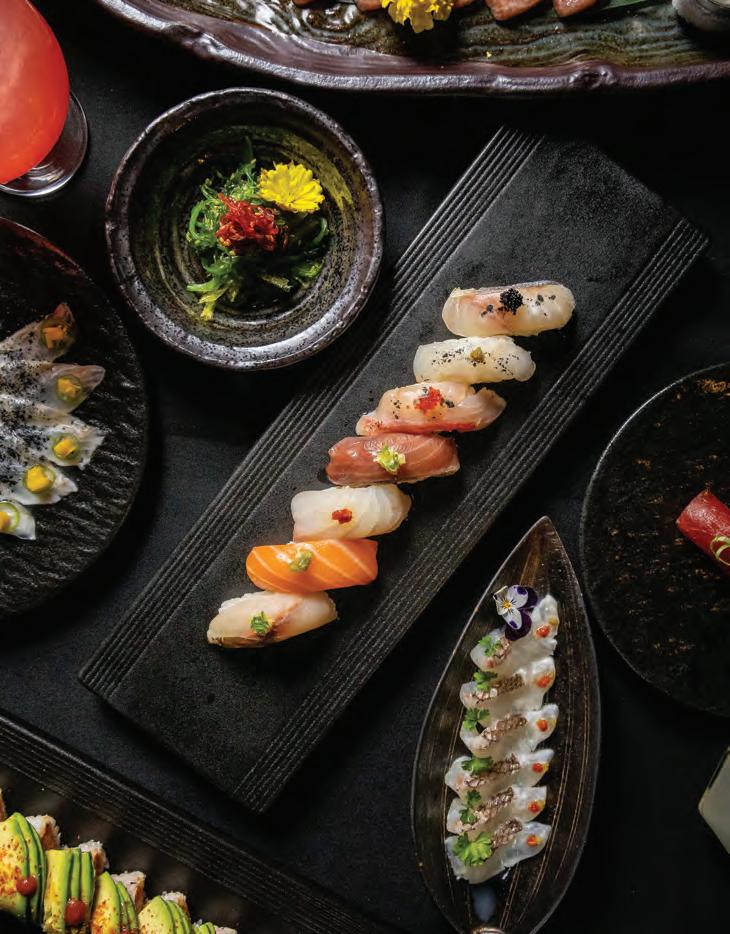
4 minute read
Dining
By Luke Netzley Pasadena Weekly Deputy Editor
After surviving a global pandemic and bringing a modern and energetic sushi experience to Pasadena, Old Town’s Kaviar Sushi Bar has celebrated its two-year anniversary.
“When it comes to fine dining sushi in LA, it’s typically your omakases: the quiet, quaint types of small sushi bars where the Japanese chefs are silent behind the bar,” Kaviar’s veteran sushi chef John Hans Yeo described. “I figured I would bring an omakase-caliber menu with fusion elements from all around the globe and put it all together into this very Vegas-esque, New York-esque aesthetic package.”
With over two decades of experience in the food and beverage industry, Yeo and Kaviar owner Tigran Oganessian sought to bring a newfound energy and creativity to Pasadena’s sushi scene through a voluminous menu of generational traditions and explorational experiments.
“I’m a firm believer in maintaining the integrity of what sushi is, both culturally and culinarily, so initially it was a little bit difficult for me when I was developing this menu because it was so different,” said Yeo, who began his prodigious career as a high school dropout with no classical training.
Yeo’s parents emigrated from South Korea to LA’s Koreatown when he was a year old before settling in Bakersfield six years later. At age 16, Yeo wanted to buy a car but felt that he could not afford it unless he had a full-time job. He dropped out and hopped from one restaurant job to another until he ended up as a dishwasher at a Japanese restaurant, which proved to be his formal introduction to Japanese cuisine.
Yeo moved to Los Angeles in 2004 and began working in sushi restaurants, building up an arsenal of recipes and learning skills from the chefs at each place he worked.
Today, Yeo stands as the executive chef of Kaviar Sushi and as a culinary creative looking to combine modern techniques and an adventurous spirit with fresh ingredients and a reverence for traditional recipes by infusing his menu with opulence and artistry.
According to Yeo, this enhancement can be as simple as adding a fresh squeeze of lemon, dash of Himalayan salt crystals and coating of yuzu paste to a Japanese snapper.
Along with a traditional sushi and maki list that would be found in a typical omakase restaurant, Yeo utilizes simplistic enhancements and fusions pulled from his childhood and from the experiences he had moving across restaurants.
Kaviar’s test kitchen has produced such creations as the restaurant’s wagyu tacos made from certified American wagyu, wonton crisp taco shells and a jalapeño guacamole made in-house as well as its pan-seared hotate served with a shoyu reduction, black caviar and a garlic aioli made in-house.
The Kaviar team also showcases its traditional skills through its sushi menu, which includes staples like goldeneye snapper, kanpachi and yellowtail.
Kaviar’s ingredients are organic and can change at a moment’s notice due to the restaurant’s “small-batch” ordering policy, which is in place so that the kitchen avoids back stocking and ensures the quality of every product.
While the quality and creativity behind the food lie at the core of Kaviar’s mission, Yeo insists that all aspects of the restaurant and its service are vital to creating a special dining experience for guests.
“I call it an experience-based sushi phenomenon, from the first time you walk in to the time you leave,” Yeo explained. “I want my diners to come in and have an ultra-fine dining experience with smoke shows and fire shows. I want them to have food and drink and be able to smile, laugh and share beautiful, long conversations with one another, to stay and
Kaviar’s sushi is made with fresh organic ingredients with quality ensured by the restaurant’s “small-batch” ordering policy.
dine for three hours if they want.”
Along with its tableside fire and smoke shows, Kaviar achieves its dining experience by its customer service and simple yet dramatic décor, including authentic suits of Samurai armor. Yeo not only wants to entertain guests with amiable conversation but with an unmatched level of education about the menu so that visitors can enter the restaurant with no knowledge of sushi and leave as experts.
By combining culinary artistry with an energetic atmosphere to create an elevated, high-end dining experience, Yeo and Oganessian have thrived in Pasadena and are looking to revolutionize the city Los Angeles’ sushi scene with their new Kaviar location, which will open at 449 S. Hewitt Street in the Arts District.
Kaviar Sushi Bar
70 N. Raymond Avenue, Suite 250, Pasadena kaviarsushi.com 11:30 a.m. to 3:30 p.m. and 6 to 9:30 p.m. Sunday to Wednesday; 11:30 a.m. to 3:30 p.m. and 6 p.m. to 10:45 p.m. Thursday to Saturday




